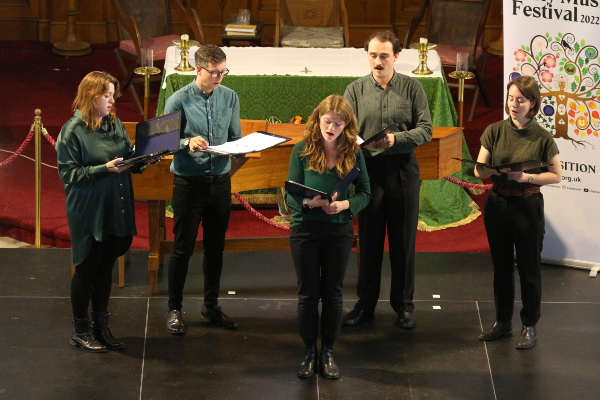Review by Lisa Newnham
This was a great idea and an ambitious project bringing together many different disciplines, voices, and instruments along with younger people from local schools. Although promoted as a multimedia this was in effect a screen at the back of the stage with projection, which changed throughout with different images, maps and edited video snippets. The main narrative being the emigratory path of the nightingale.
The migration was suggested via the screen – we see a map, then the bird outline flies to different places, and when it alights, we had a piece of music associated with that place. We started on a simple farm in Norfolk, then set off; the flight following our birds out of Sussex with music from the medieval Lewes Breviary; across France with Clément Janequin’s wonderfully quirky Le chant des oiseaux; through Spain and Portugal with the extraordinary Lamentations by João Lourenço Rebelo; before pausing at the interval and then leaping across the sea to Morocco for fabulous traditional songs about birds; and finally settling to The Gambia and the stunning music for voice and kora belonging to the ancient Griot traditions.

The nightingale was called Billie, some of the music had bird associations, whilst drifting off to some rather delightful lamentations: ‘Forest fires south of Lisbon on the way to Cádiz’. I reflected how little regional texture there was in the early European music selection. I felt it lacked a national topographical distinction to the musical pieces selected, I could follow the geography of the migration through the projection and programme, but this distinction felt lacking in the music itself.
At the beginning, before the bird sets off, children from Elm Grove and Westdene Primary schools formed a children’s choir, performing a fun song created by director Jeremey Avis called Eating Worms. It seemed as if half the audience were parents of the younger people as there was surge of phones to video the moment. It’s good to see children included in an early music festival event and BREMF are to be applauded for engaging with this audience and demographic in this authentic and inclusive way. This was a fun way of ensuring a family event involved younger peoples having positive experiences of early music.
Later on the children joined in the call with the African performers; Simo Lagnawi, representing Morocco, playing the guembri – a three stringed skin-covered bass plucked lute used by the Gnawa people, the size of a guitar, with a body carved from a log and covered on the playing side with camel skin. Joining them in this bouncy ‘call and response’ was Suntou Susso playing the Kora – a harp-lute with 22 strings – which is unique to the Mandinka people of West Africa and The Gambia.

These stunning musicians with their unique instruments along with two different choirs, and a quartet – Horizon Voices – stepped in and out of the performance spaces mixing and exchanging tempos, rhythms and ambience before they came together just before the interval in an emotive newly commissioned piece called Two Weeks. The whole company came together to sing, summing up an idea of human migration and movements of people. The music here was effective and moving, bringing a range of voice and experience to the stage all at once.
Abruptly the visuals changed into startling images of African refugees and migrants wrapped in silver blankets being ‘tended to’ by Europeans. I felt there might have been a more subtle and powerful way of presenting human migrations across the Mediterranean. The sheer desperation and hardships of refugees can not be usefully represented by such ‘stock footage’ that we see on the news, and which itself contains a subtext which does not respect the dignity of such struggles and the people that undertake them. After all, nightingales and humans have migrated for thousands of years – Billie the bird knows no borders and nations are a human invention.
You can see a full list of cast, creative and the music performed in this evening in the programme here:
Brighton Community Choir joined in to sing specially create music for the event. It was good to hear such a wide range of voices and different choirs taking part – it made the whole event feel like a well-developed community event. The different types of early music contrasted well with the traditional instrumental music from Africa, interlaced with commissioned pieces of music from composer and director Jeremy Avis
The African performers and musicians were a real highlight of the event, lifting the whole performance and shifting the Eurocentric focus of many early music events and reminded us that these traditional instruments have been in use widely as long as European early musical traditions. It felt like a successful family-oriented melding of BREMF and WOMAD.

Lagnawi and Susso interacted exceptionally with the younger members of the ensemble and injected real energy into the performance bringing to life the ‘call and response’ and giving the younger people an opportunity to take part in something special with internationally renowned musicians.
This was an ambitious community event with much to celebrate and enjoy with a few areas which could have been more polished, with clearer journey and native avian narratives.
BREMF continues across the city until the end of the month and you find out more, and book events on their website here:














You must be logged in to post a comment.